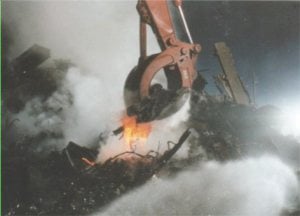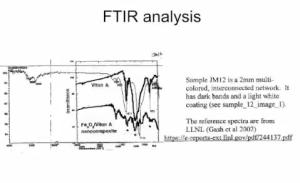9/11 Truth: How to Debunk WTC Thermite at Ground Zero

The evidence for the presence of thermite at the World Trade Center (WTC) on 9/11 is extensive and compelling. This evidence has accumulated to the point at which we can say that WTC thermite is no longer a hypothesis, it is a tested and proven theory. Therefore it is not easy to debunk it. But the way to do so is not difficult to understand.
To debunk the thermite theory, one must first understand the evidence for it and then show how all of that evidence is either mistaken or explained by other phenomena. Here are the top ten categories of evidence for thermite at the WTC.
- Molten metal: There are numerous photographs and eyewitness testimonies to the presence of molten metal at the WTC, both in the buildings and in the rubble. No legitimate explanation has been provided for this evidence other than the exothermic reaction of thermite, which generates the temperatures required and molten iron as a product.
- The fires at Ground Zero could not be put out for several months. Despite the application of millions of gallons of water to the pile, several rainfall events at the site, and the use of a chemical fire suppressant, the fires would not subside. Thermal images made by satellite showed that the temperatures in the pile were far above that expected in the debris from a typical structure fire. Only thermite, which contains its own oxidant and therefore cannot be extinguished by smothering it, can explain this evidence.
- Numerous eyewitnesses who were fleeing the area described the air mass as a hot wind filled with burning particles.[1] This evidence agrees with the presence of large quantities of thermite byproducts in the air, including hot metallic microspheres and still-reacting agglomerates of thermite.
- Numerous vehicles were scorched or set on fire in the area. Photographic evidence shows that cars parked within the lower-level garage areas of the WTC complex burned as if impacted by a super-hot wind like that described by the eyewitnesses. All non-metallic parts of the cars, including the plastic, rubber, and glass, were completely burned off by a hot blast.
- There was a distinct “white smoke” present—clearly different from smoke caused by a normal structural fire—as indicated by eyewitnesses and photographic evidence.[2]The second major product of the thermite reaction is aluminum oxide, which is emitted as a white solid shortly after reaction.
- Peer-reviewed, scientific research confirmed the presence of extremely high temperatures at the WTC. The high temperatures were evidenced by metallic and other microspheres, along with evaporated metals and silicates. These findings were confirmed by 9/11 investigators and by scientists at an independent company and at the United States Geologic Survey.
- The elemental composition of the metallic microspheres from the WTC dust matches that of metallic microspheres produced by the thermite reaction.
- The environmental data collected at Ground Zero in the months following 9/11 indicate that violent incendiary fires, like those produced by thermite, occurred on specific dates. Peer-reviewed scientific analysis of these data show that the components of thermite spiked to extraordinary levels on specific dates in both the air and aerosol emissions at Ground Zero.
- Carbon nanotubes have been found in the WTC dust and in the lungs of 9/11 first responders. Formation of carbon nanotubes requires extremely high temperatures, specific metal catalysts, and carbon compounds exactly like those found in nanothermite formulations. Researchers have discovered that nanothermite produces the same kinds of carbon nanotubes. That finding has been confirmed by independent analysis in a commercial contract laboratory.
- A peer-reviewed scientific publication has identified the presence of nanothermite in the WTC dust. One of the critical aspects of that paper has been confirmed by an independent scientist.
There is also a great deal of indirect evidence for the thermite theory. This includes the attempts by NIST to downplay the evidence for thermite. It also includes things like a weak effort by Rupert Murdoch’s National Geographic Channel to discredit the ability of thermite to cut structural steel, which was itself roundly discredited by one independent investigator. It is now unquestionable that thermite can cut structural steel as needed for a demolition.
Therefore, debunking the WTC thermite theory is not easy but is very straightforward. Doing so simply requires addressing the evidence listed above point by point, and showing in each case how an alternative hypothesis can explain that evidence better. Given the scientific grounding of the thermite theory, use of the scientific method, including experiments and peer-reviewed publications, would be essential to any such debunking effort.
That is almost certainly why we have seen no such debunking. Instead, the people working to refute the WTC thermite theory have resorted to what might be called a case study in how NOT to respond to scientific evidence.
The failed thermite theory debunkers have produced:
- Thousands of chat room comments and other posts yet not one peer-reviewed scientific article.
- Alternate hypotheses that have little or no evidence to support them. For example, themini-nuke hypothesis and the “Star Wars Beam” hypothesis.
- Government scientists declaring that the evidence simply doesn’t exist.
- Attempts to exaggerate the meaning of the evidence, for example by saying that thermite or nanothermite could not have caused all of the effects seen at the WTC.
- Deceptive efforts to introduce the government contractors who created the official accounts as independent scientists.
The last of these methods has been the most popular. Trying to debunk the tenth piece of evidence for WTC thermite, NIST contractor James Millette produced an unreviewed paper that purports to replicate the finding of nanothermite in the WTC dust. This was apparently organized in the hope that doing so would discredit all of the evidence for thermite at the WTC.
Millette is well known for having helped create the official reports on the analysis of WTC dust. He was responsible for creating the form that was used to pre-screen all materials found in the dust prior to any analysis by official investigators. Those official reports did not mention any of the evidence listed above, in particular failing to report the abundant iron microspheres scattered throughout the WTC dust. Additionally, Millette’s official report team did not find any red-gray chips, let alone nanothermite.
As he worked to debunk the WTC thermite research, Millette was still unable to find any iron microspheres. But he did claim to have finally found the red-gray chips. Curiously, he did not attempt to replicate the testing that would determine if those chips were thermitic.
Claiming to have found the chips, Millette perfomed an XEDS analysis for elemental composition but failed to do any of the other tests including BSE, DSC, the flame test, the MEK test, or measurement of the chip resistivity. Having inexplicably “ashed” the chips at 400 °C in a muffle furnace, thereby proving that they were not the materials of interest (which ignite at 430 °C), Millette ignored the remainder of the study he had set out to replicate. Because he did not do the DSC test, he could not do XEDS of the spheres formed from the chips. Since he had still not found spheres in the dust, he could not test those and this allowed him to ignore the testing of spheres from the thermite reaction.
 Millette rested his case on FTIR, which I have also performed on chips from WTC dust but with a much different result. Like Millette’s paper, my FTIR work is not yet part of a peer-reviewed publication and therefore should not be taken as authoritative evidence. There has been less urgency to this supplemental work because what has been done to date has received no legitimate response from the government or from much of the scientific community. That sad fact should be the central point of discussion today.
Millette rested his case on FTIR, which I have also performed on chips from WTC dust but with a much different result. Like Millette’s paper, my FTIR work is not yet part of a peer-reviewed publication and therefore should not be taken as authoritative evidence. There has been less urgency to this supplemental work because what has been done to date has received no legitimate response from the government or from much of the scientific community. That sad fact should be the central point of discussion today.
In any case, Millette attempted only one tenth of the tests in his struggle to replicate (or refute) one tenth of the evidence for thermite at the WTC. His un-reviewed “one percent approach” was nonetheless very convincing to many people, including some of the people who produced the official reports for 9/11. But it is obvious to others that Millette’s work was not a replication in any sense of the word.
I’m looking forward to the peer-reviewed scientific article that finally does replicate the nanothermite paper or any of the other peer-reviewed scientific papers that document the evidence for thermite at the WTC. Hopefully, we can approach those efforts without concerns about the sources and without recalling all the deception and manipulation that preceded them.
Until then, it is important to recognize the difference between the superficial appearance of science and the actual practice of science. Ignoring 90 percent of the evidence is not scientific. And replication of the 10 percent means actually repeating the work. If thermite debunkers and alternate hypothesis supporters can find the courage and focus to step through that challenge, maybe they can begin to add to the discussion.
Notes
[1] Here are only a few examples of the hot wind:
“Then the dust cloud hits us. Then it got real hot. It felt like it was going to light up almost.” -Thomas Spinard, FDNY Engine 7
“A wave — a hot, solid, black wave of heat threw me down the block.” – David Handschuh,New York’s Daily News
“When I was running, some hot stuff went down by back, because I didn’t have time to put my coat back on, and I had some — well, I guess between first and second degree burns on my back.” -Marcel Claes, FDNY Firefighter
“And then we’re engulfed in the smoke, which was horrendous. One thing I remember, it was hot. The smoke was hot and that scared me” -Paramedic Manuel Delgado
“I remember making it into the tunnel and it was this incredible amount of wind, debris, heat….” -Brian Fitzpatrick FDNY Firefighter
“A huge, huge blast of hot wind gusting and smoke and dust and all kinds of debris hit me” -Firefighter Louis Giaconelli
“This super-hot wind blew and it just got dark as night and you couldn’t breathe” -Firefighter Todd Heaney
[2] For example, see Joel Meyerowitz, Aftermath: World Trade Center archive. Phaldon Publishing, London, p 178. See photograph of the event on 11/08/01 that shows a stunning and immediate change of cloud-like emissions from the pile, from dark smoke to white cloud.

